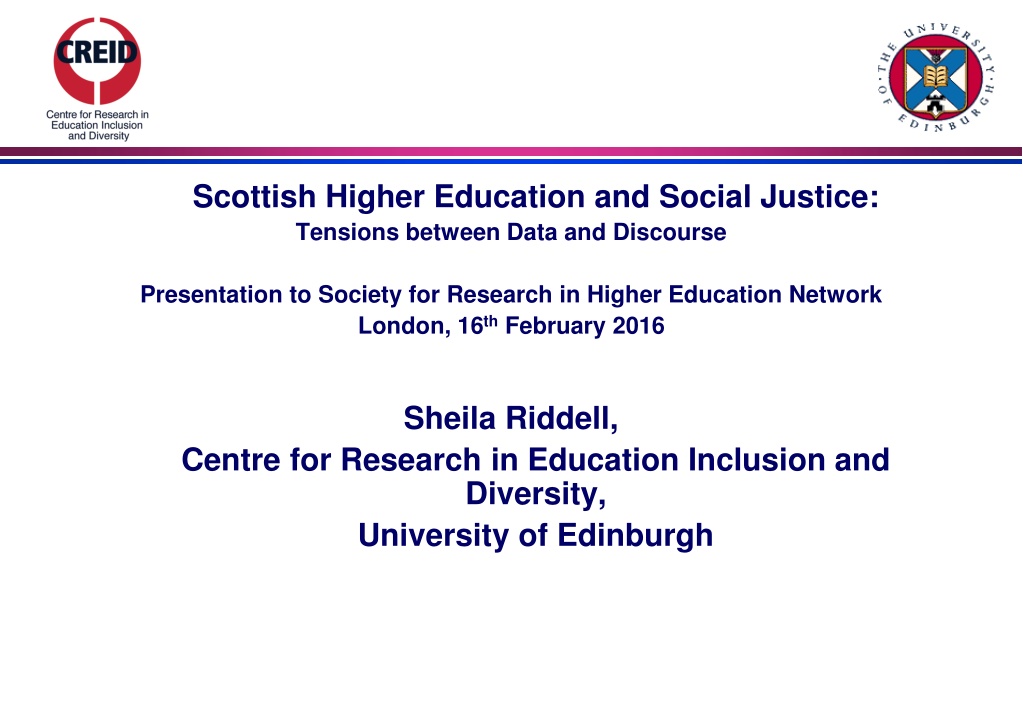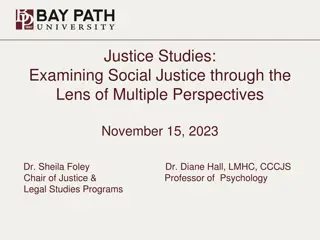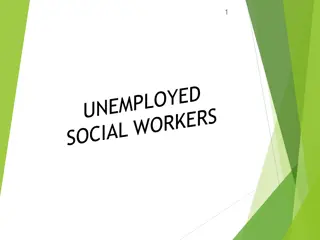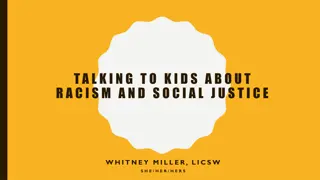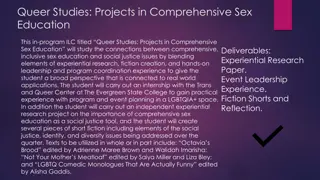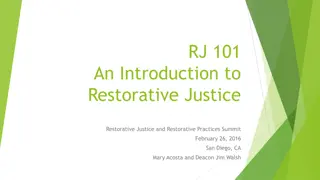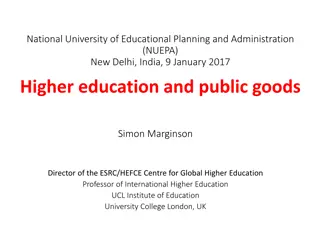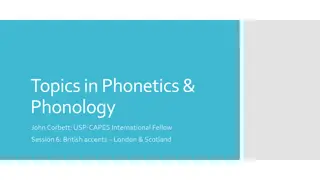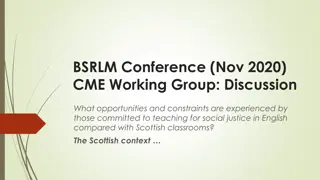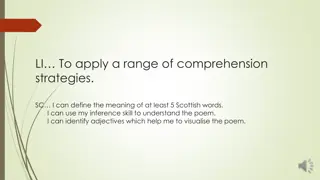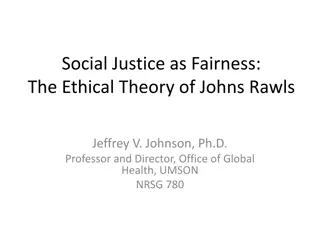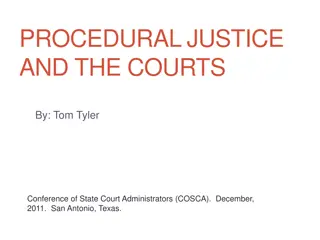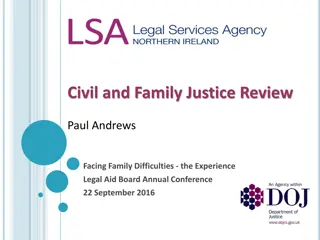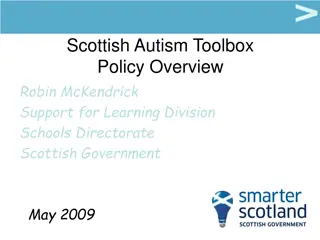Understanding Social Justice in Scottish Higher Education
Explore the complexities of social justice in Scottish higher education through the lens of data and discourse. Delve into questions about fairness, student demographics, financial resources, and the impact of free undergraduate tuition on creating a more equitable system. Learn about research methods used to investigate social characteristics of students, cross-border student flows, and attitudes towards widening access. Examine the interpretation of social justice in higher education and the challenges in defining and achieving fairness. Consider the Scottish government's objectives in promoting equal opportunities in education.
Download Presentation

Please find below an Image/Link to download the presentation.
The content on the website is provided AS IS for your information and personal use only. It may not be sold, licensed, or shared on other websites without obtaining consent from the author. Download presentation by click this link. If you encounter any issues during the download, it is possible that the publisher has removed the file from their server.
E N D
Presentation Transcript
Scottish Higher Education and Social Justice: Tensions between Data and Discourse Presentation to Society for Research in Higher Education Network London, 16thFebruary 2016 Sheila Riddell, Centre for Research in Education Inclusion and Diversity, University of Edinburgh
Central question raises a large number of additional questions: How is social justice or fairness understood in relation to Scottish higher education? What are the social characteristics of students in Scottish higher education and in different types of institution? How are financial resources distributed across different education sectors, and what can we learn from these priorities? Does free undergraduate tuition automatically produce a fairer system?
Research methods ESRC project Higher Education in Scotland, the Devolution Settlement and the Referendum on Independence Review of policy and administrative data Analysis of HESA data to investigate social characteristics of HE students across UK (social class, gender & ethnicity) and the nature of cross-border student flows Interviews with young people in schools to investigate HE ambitions, attitudes to student finance and widening access (c.100 interviews) Interviews with key informants in Scotland, England, rest of the UK and internationally (c. 50 Scottish interviews) Knowledge production of a film and teaching materials exchange activities, including seminar series,
What is meant by social justice in the context of higher education? Scottish policy documents rarely define Social justice refers to beliefs about the way in which the good and bad things in life should be distributed among members of a society . Recent writing on social justice identifies (at least) three inter-connected domains (re)distribution (of economic and social resources), recognition (accordance of respect to different (participation in social institutions and governance regimes) groups) and representation All three domains important in HE but what criteria should be used to judge degrees of fairness? Social democratic states often focus on equal opportunities different outcomes are tolerated because everyone has (ostensibly) the same initial chance to succeed. Equal outcomes approaches more unusual. Phillips suggests that unequal group outcomes should be regarded as evidence of systemic injustice.
Ambiguity In Scottish Government s objectives? The Government s ambition is that a child born today in one of our most deprived communities should, by the time he or she leaves school, have the same chance of going to university as a child born in one of our least deprived communities . -- Interim Report, Commission on Widening Access, 2015
Tuition fees policy - central area of divergence between Scotland and England belief that this policy would automatically deliver fair participation in HE Free university tuition fee became flagship policy of SNP Government particularly during referendum campaign of 2013/14. Independence White Paper argued that Scottish HE based on ability to learn, rather than ability to pay in contrast with marketised English system. November 2014 - former First Minister Alex Salmond placed stone at Heriot Watt University engraved with the following words: The rocks will melt with the sun before I allow tuition fees to be imposed on Scotland s students
Has fairness been delivered? University application & entry rates by country and neighbourhood deprivation (data complexity!) Scotland has lower rate of university participation compared with other jurisdictions. But Scotland has higher HEIPR (Higher Education Initial Participation Rate) compared with England. In 2013/14, Scottish HEIPR for those aged between 16 and 30 was 55%, compared with English rate of 47% Higher Scottish HEIPR explained by greater use of colleges. 17% of all Scottish HE takes place in colleges, compared with 6% in England. Policy has both pros and cons.
University application & entry rates by country and neighbourhood deprivation Compared with other UK jurisdictions, Scotland has lowest rate of university participation by those from most deprived neighbourhoods - 18 year olds from more advantaged areas are five times more likely to apply to university and four times more likely to enter than those from poorer areas. At the same time, Scotland has lowest difference in entry rates between most and least deprived areas this is partly driven by SG s decision to allocate widening access places specifically for students from deprived backgrounds - 720 earmarked for higher tariff institutions. Because SG pays up front for university tuition, number of university places are strictly controlled c.f. lifting of cap in England. HE expansion in Scotland driven by colleges.
18 year old entry rates for disadvantaged areas (POLAR3 Q1) by country of domicile, 2015
January deadline application rates by country for 18 year olds (most disadvantaged areas, POLAR3 quintile 1) 2016
18 year old entry rates for advantaged areas (POLAR3 Q5) by country of domicile 2015
January deadline application rates by country for 18 year olds (most advantaged areas, POLAR3 quintile 5) 2016
January deadline application rates by SIMD quintile for Scottish 18 year olds (SIMD quintile 5 are the most advantaged areas)
18 year old entry rate ratios (higher tariff providers): most advantaged areas (POLAR3 Q5) to most disadvantaged areas by country of domicile
Young Scottish-domiciled SIMD20 entrants to full-time undergraduate courses at selected Scottish HEIs, 2005-06 to 2014-15 Notes: (1) Edinburgh College of Art (ECA) merged with the University of Edinburgh on 1 August 2011. These figures for the University of Edinburgh for earlier sessions include students at ECA. (2) Contains the figures for Bell College and the University of Paisley for 2005-06 and 2006-07. These institutions merged on 1 August 2007 to become the University of the West of Scotland.
Complexity of data leads to partial citation for political purposes Danny Dorling:
Inequality in participation by different social groups in Scotland Higher Education Institutions attended by student background: young Scottish- domiciled students entering HEIs in Scotland (Source: HESA record 2012/13) Ancient Other pre-92 Post-92 Other HEI Independent school State school Higher Managerial/professional Lower Managarial/professional Intermediate Working class 0% 10% 20% 30% 40% 50% 60% 70% 80% 90% 100%
.and in England Higher Education Institution attended by student background: young English-domiciled students entering HEIs in England (Source: HESA Student record 2012/13) Russell Group Other Pre-1992 Post-1992 Other HEI Independent school State school Higher Managerial/Professional Lower Managerial/Professional Intermediate Working class 0% 10% 20% 30% 40% 50% 60% 70% 80% 90% 100%
Pros and cons of college as entry route to HE 8.5% of full-time first degree entrants to Scottish universities from SIMD20 backgrounds. 23% of HE college students from SIMD20 backgrounds colleges may be close to home and offer friendlier environment. Also, much cheaper form of HE for government. Only 50% of HN students progress to university generally to post-92 institutions. In 2013/14, only 12 students from SIMD20 areas progressed to ancient universities with full credit, 10 with partial credit and 91 with no credit (i.e. began again in first year). For these students, an honours degree would take 6 years, with a 50% drop-out rate.
Distribution of Scottish Government education budget 2012-13 2000 1 Fee payments abolished for Scottish students studying in Scotland. 1,000 fee continues for all other students in the UK. 2001 2 2002 3 2004 5 2006 7 2012 3 2013 4
Marked social inequalities in school attainment particularly at higher levels Children from more least deprived neighbourhoods twice as likely to get one Higher as those from most deprived neighbourhoods 2000 1 Fee payments abolished for Scottish students studying in Scotland. 1,000 fee continues for all other students in the UK. 2001 2 2002 3 2004 5 2006 7 2012 3 2013 4
Highest qualifications attained by Scottish state school leavers by SIMD decile Percentage achieving 1-2 SCQF Level 7 (Advanced Highers) % Percentage achieving 3+ SCQF Level 7 (Advanced Highers % Total % school leavers likely to be qualified for direct university entry Percentage achieving 5+ SCQF Level 6 (Highers) % SIMD Decile Most deprived 20% 4.9 5.2 0.45 10.5 8.25 9.25 0.7 18.2 20-40% 10.2 14.55 1.7 26.45 40-60% 13.05 19.05 2.85 34.95 60-80% Least deprived 20% 17 26.9 4.65 48.55
Beliefs of Scottish policy makers: Defence of free tuition by senior managers in ancient universities 2000 1 [The policy of free undergraduate tuition] is sustainable so long as the Government is prepared to make difficult decisions. And at the end of the day this is very simply just an allocation of resource. And the Scottish Government at the moment is prepared to say that it wishes to fund higher education as a free good. And therefore not to fund other things. This is entirely sustainable as long as the Scottish Government maintains a commitment that it wishes to prioritise higher education for the benefit of the Scottish economy . Fee payments abolished for Scottish students studying in Scotland. 1,000 fee continues for all other students in the UK. 2001 2 2002 3 2004 5 2006 7 2012 3 I think in the long term [free tuition] will promote access. It will promote more inclusivity and fairness. . I think in the long run what 2013 4 we re doing in Scotland is sustainable and what they re doing in England isn t .
Also the view of the UCU, Unison and the NUS 2000 1 Fee payments abolished for Scottish students studying in Scotland. 1,000 fee continues for all other students in the UK. 2001 2 We largely support the, inverted commas, free tuition at the higher education level. We think that that is the right approach although we do recognise it hasn t achieved what we d like to achieve which is better access for those from disadvantaged communities to university. So we don t think it s a panacea or a silver bullet to that issue. We think we have to do much more in that area, but it is nonetheless right in our view that access to education is free at the point of use. (Unison Scotland official) 2002 3 2004 5 2006 7 2012 3 2013 4
But college managers express scepticism about government policy on free tuition [The rhetoric was that] the stones would melt in the sun in Sauchiehall Street before they would impose fees. And that was a bit of rhetoric which I think was designed for public consumption which is, We are Scottish, we value education. Those philistines in England don t Sorry, that s my gloss on it! But that was making a policy distinction for public consumption very clear.
Also scepticism about university commitment to widening access Fee payments abolished for Scottish students studying in Scotland. 1,000 fee continues for all other students in the UK. in further education colleges, it s about transformative education, transformative experiences. I don t think FE can be beaten on that. And it has struck me that historically there s been a tendency for universities to suit themselves and they tend to, when it comes to things like articulation and credit transfer When you look at the evidence it seems to suggest that, by and large, they are for people from a particular background .I don t think it s really changed that much and I know they ll say, Oh it s nothing to do with us Guv. It s all to do schools are not producing enough kids from these areas with the right profiles , blah de blah de blah. So yeah I think the [university] sector s got a bit of a swagger about it, a bit of a conceit even. (College manager) 2000 1 2001 2 2002 3 2004 5 2006 7 2012 3 2013 4
Conclusion: How fair is access to Scottish higher education? Major problems with distributional justice 2000 1 Scotland prides itself on providing free university tuition on the grounds that education is a universal service which benefits all and should be free to all. Fee payments abolished for Scottish students studying in Scotland. 1,000 fee continues for all other students in the UK. 2001 2 Consequences of free tuition include capped numbers and reduced spending in schools and colleges. 2002 3 2004 5 2006 7 However, the greatest beneficiaries are those from socially advantaged backgrounds not redistributive. Free tuition in Scotland has not achieved higher rates of participation or greater 2012 3 student diversity compared with England. Key informant interviews suggest divided views free tuition strongly defended by ancient universities, trades unions and the NUS but criticised by colleges. 2013 4 More informed public debate needed on intended and unintended outcomes of current system, what might count as a fair system and measures likely to promote change.
